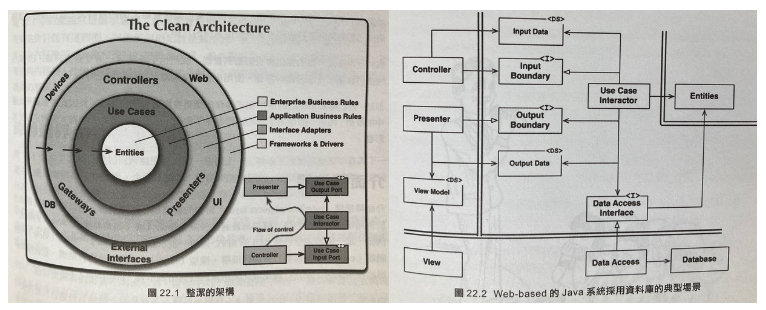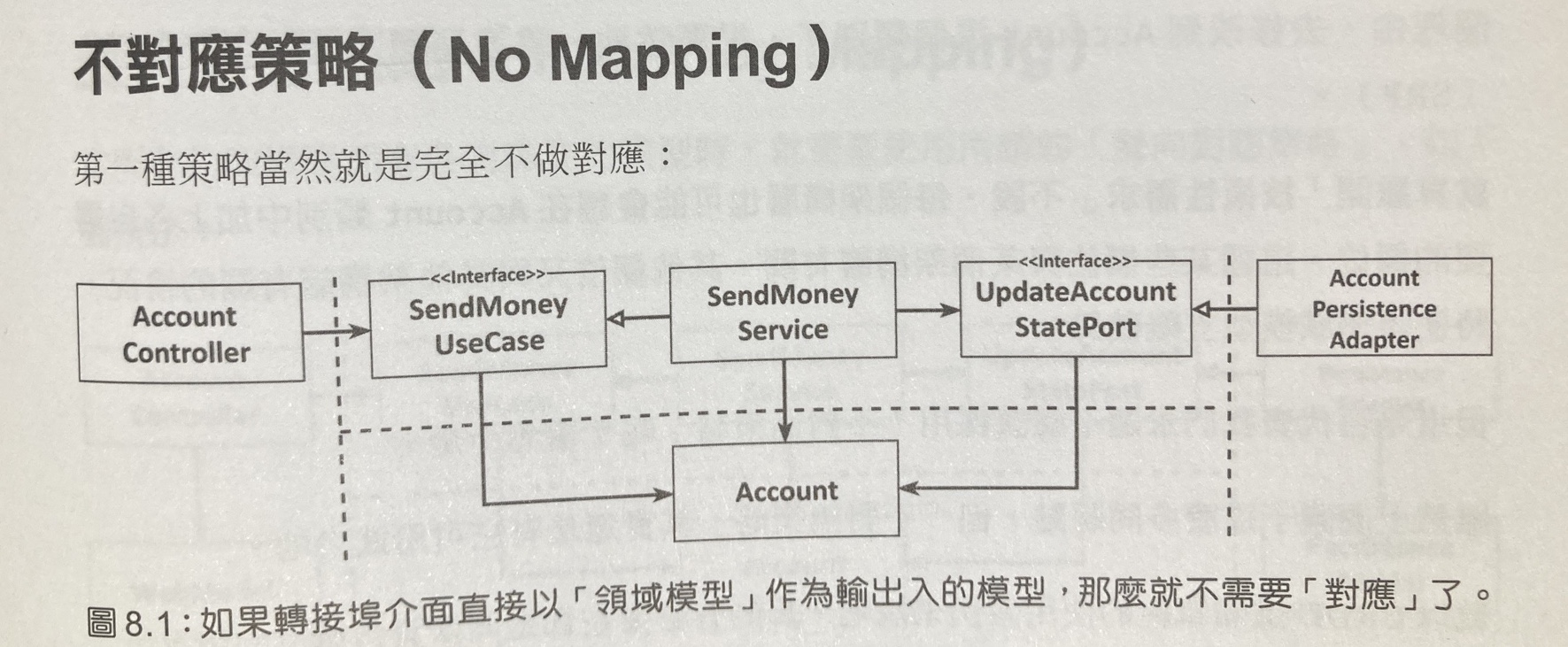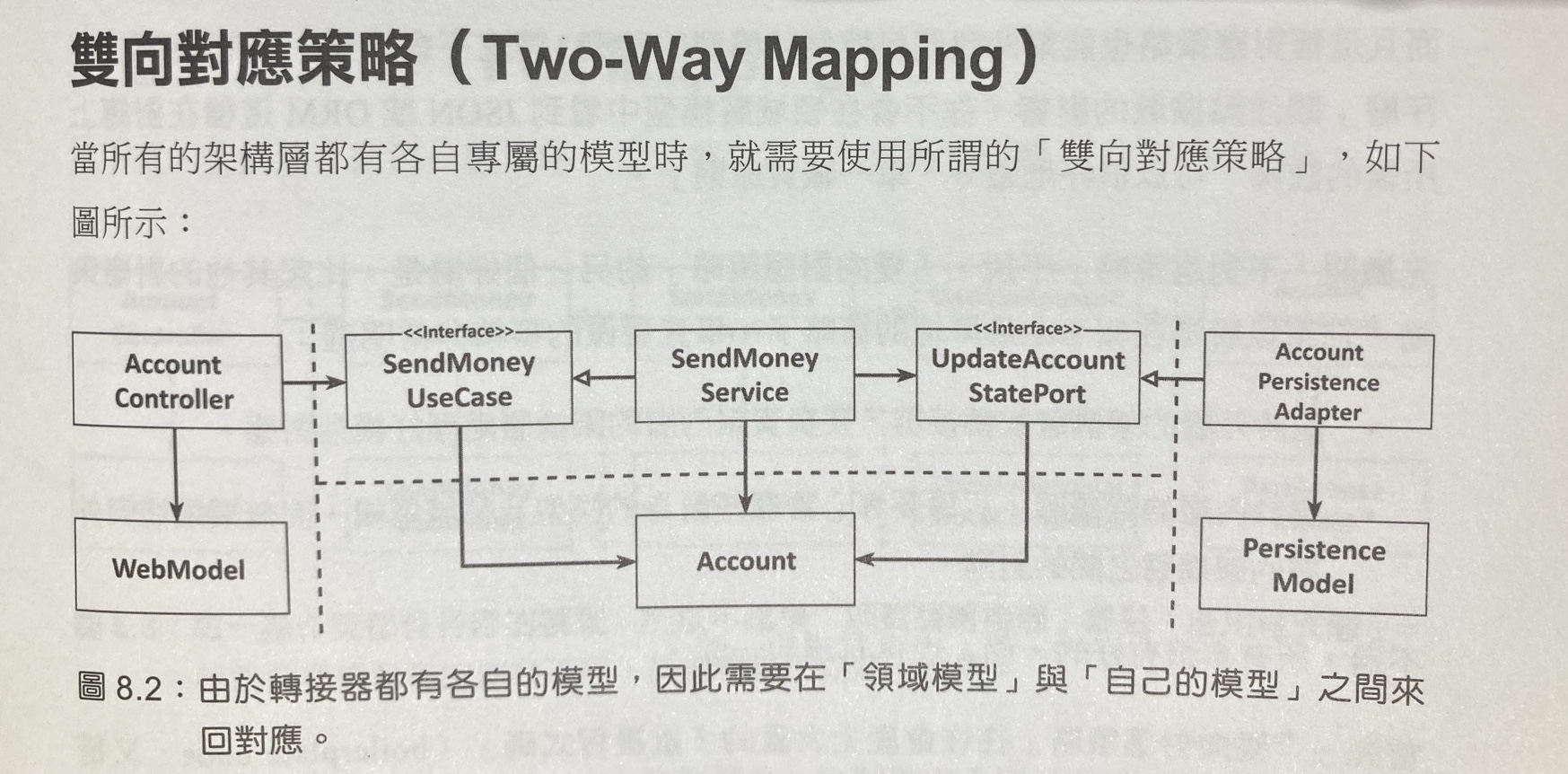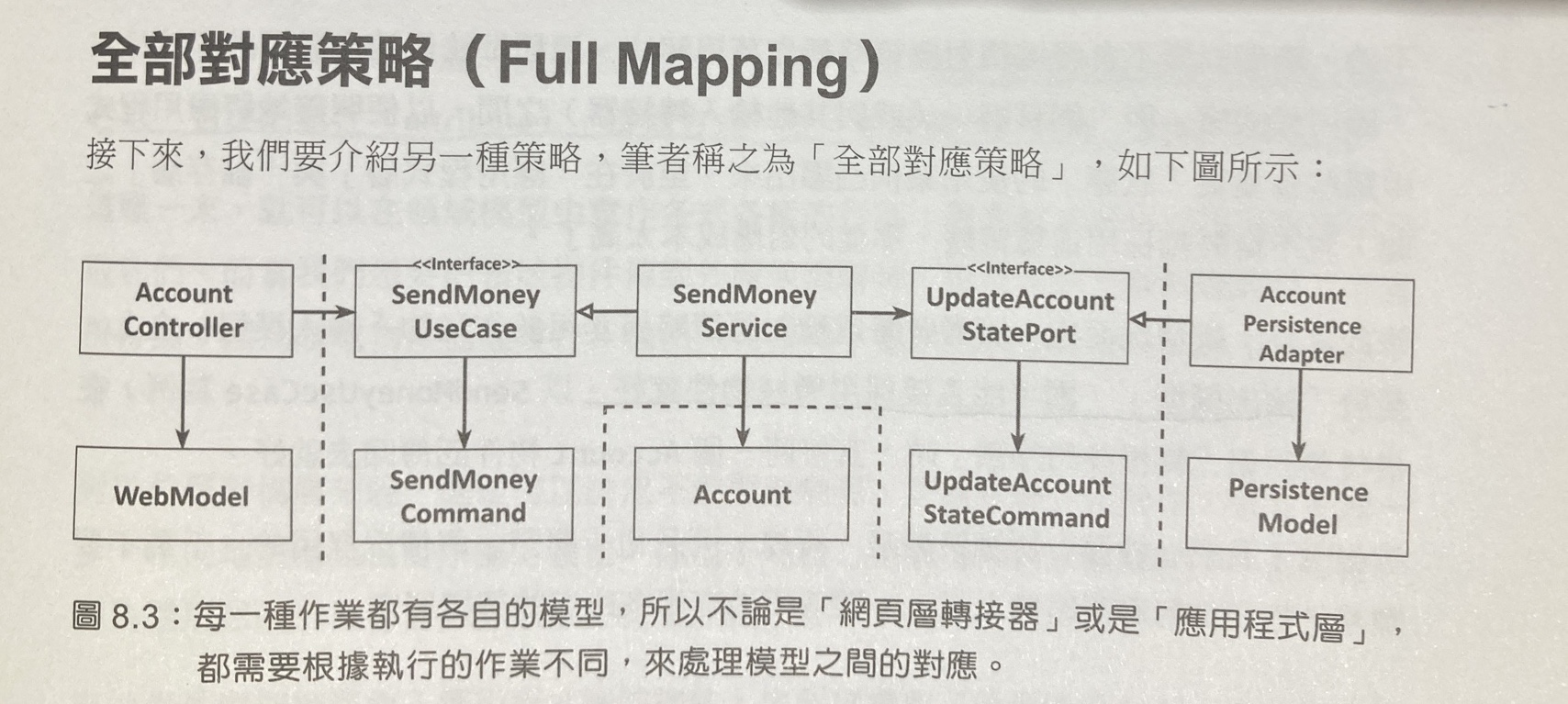在一月初時上 Teddy 的 DDD 課程時,第一次見識到 DDD 結合 Clean Architecture,可以將設計跟實作完美的結合,打造出彈性、易懂、好維護的程式碼,就一直對 Clean Architecture 很感興趣 (課程 ezKanban 原始碼);
後來在 2022 Coscup 上聽到強者 Jalex 分享 Clean Architecture in Go: The Crescendo Way 提供了另一種實作的方式;
最後在看【Clean Architecture 實作篇】時,作者又提供另一種方式以六角架構為基底的實作
在看了這幾種不同實作的角度後,整理一下實作 Clean Architecture 中不同層轉換的取捨
Clean Architecture 的解讀
【Clean Architecture】一書談了非常多的觀念,整理後自己的解讀是 架構是為了降低後續的開發、維運成本並最大化工程師的產能,而在這樣的原則下提出了以下的依賴原則

- 離 IO 越遠的元件越是核心,而核心不應該因為外層的改變而受到影響,就好比說用戶不會在意資料庫是用 MySQL 還是 MongoDB (IO),他只會在意他購買的品項與折扣對不對 (業務規則)
- 依賴的物件不可以跨層,所以 Adapter 不能直接存取 Entity
所以從內而外,可以分成 Entity (Domain Object) / Use Case / Adapter (Controller, Gateway, Repository - 常指 DB 儲存層) 等
六角架構
 由 Alistair Cockburn 提出的六角架構,剛好與 Clean Architecture 觀點呼應,外部 IO (Adapter) 如果要與內層 (Entity / Use Case) 互動必須通過
由 Alistair Cockburn 提出的六角架構,剛好與 Clean Architecture 觀點呼應,外部 IO (Adapter) 如果要與內層 (Entity / Use Case) 互動必須通過 Port,這些 Port 會透過依賴反轉當作隔離層,避免內層被外層的變動而改變
Port 方向依照核心的對應有兩種
- In 從外層呼叫核心
- Out 核心呼叫外層 (透過 interface)
跨層的溝通原則
在【Clean Architecture】一書中,提到如果跨層的話內層的物件是不可以直接被輸出到更外層,例如 Entity 只能在 Use Case 使用,如果要傳到 Controller , Gateway,必須再轉一層 DTO (data to object),反之從外層往內傳也是,這是為了符合 SRP 單一職責
例如一般的 web request,會從 Controller 取得參數 -> Use Case + Entity 處理業務邏輯 -> Controller 回傳結果,此時如果 Controller 在顯示結果直接依賴於 Entity,那 Entity 就會可能因為 API 要多回傳某個欄位而受到改動,違反最一開始的原則
但是如果每一層之間都需要 DTO 轉換,那程式碼會很多重複宣告,因為我們透過重複取代耦合,在【Clean Architecture 實作篇】有整理幾種方式,供大家取捨
1. No Mapping 跨層不轉換
 先看跨層完全不轉換的方式,參考我用 golang 實作的版本 github/no-mapping,這邊我的 Entity 宣告混雜了 Controller 的 json tag 與 ORM 的 tag
先看跨層完全不轉換的方式,參考我用 golang 實作的版本 github/no-mapping,這邊我的 Entity 宣告混雜了 Controller 的 json tag 與 ORM 的 tag
1
2
3
4
5
6
7
8
9
10
11
12
13
14
15
16
17
18
| // Entity
type Order struct {
gorm.Model
ID int `json:"id" gorm:"autoincrement"`
Price int `json:"price"`
Count int `json:"count"`
Total float64
CreatedAt time.Time
}
// Use Case
func (s CreateOrderService) Action(o *domain.Order) *domain.Order {
withTax := 1.1
o.Total = float64(o.Count*o.Price) * withTax
o.CreatedAt = now()
s.saveOrder.SaveOrder(o)
return o
}
|
在後續的 Controller / Gateway 中,就直接使用 Entity
1
2
3
4
5
6
7
8
9
10
11
12
13
14
15
16
17
18
19
20
| // Repo 儲存資料
func (r OrderRepository) SaveOrder(o *domain.Order) {
result := r.db.Create(&o)
fmt.Println(result.Error)
}
// Controller 直接用 Entity 取得 API request 內容
// 並傳入 UseCase 中
func (c *OrderController) CreateOrder(ctx *gin.Context) {
var srv = service.NewCreateOrder(c.repo)
var order domain.Order
if err := ctx.ShouldBindJSON(&order); err != nil {
ctx.JSON(http.StatusBadRequest, gin.H{"error": err})
return
}
srv.Action(&order)
ctx.JSON(http.StatusOK, gin.H{"total": order.Total})
}
|
優缺點
如果是很單純的 CRUD,API / DB 的資料格式都一模一樣才會使用,減少不必要的跨層轉換;
但缺點是如果 API / DB 格式開始分歧,Entity 就會受到污染,出現部分欄位只有在特定用途使用,而不是跟業務邏輯有關,就像是 CreatedAt 欄位只是為了 DB 紀錄,卻出現在業務邏輯上不太合理;
再加上如果未來不用 json 而走 gRPC,那 Entity 就要重新改 tag,因為 IO 變化而改動 Entity 違反了 Clean Architecture 原則
所以建議還是少用
2. Two way mapping
 github/two-way mapping 則是 Controller / Gateway 獨立宣告自己的物件,建立出 Entity後再傳入 Use Case 中
github/two-way mapping 則是 Controller / Gateway 獨立宣告自己的物件,建立出 Entity後再傳入 Use Case 中
1
2
3
4
5
6
| type Order struct {
ID int
Price int
Count int
Total float64
}
|
1
2
3
4
5
6
7
8
9
10
11
12
13
14
15
16
17
18
19
20
21
22
23
24
25
26
27
28
29
30
31
32
33
34
35
36
37
38
39
40
41
42
43
| // Repo 獨立 DAO 定義
type OrderDAO struct {
Id int `gorm:"autoincrement"`
Price int
Count int
Total float64
CreatedAt time.Time
}
func (r OrderRepository) SaveOrder(o *domain.Order) {
// 用 Entity 去轉換 DAO
orderDao := OrderDAO{
Price: o.Price,
Count: o.Count,
Total: o.Total,
}
result := r.db.Create(&orderDao)
fmt.Println(result.Error)
}
// Controller 獨立 Request Object
func (c *OrderController) CreateOrder(ctx *gin.Context) {
var srv = service.NewCreateOrder(c.repo)
// 獨立 DTO
type CreateOrderRequest struct {
Price int `json:"price"`
Count int `json:"count"`
}
var o CreateOrderRequest
if err := ctx.ShouldBindJSON(&o); err != nil {
ctx.JSON(http.StatusBadRequest, gin.H{"error": err})
return
}
// DTO 重建 Entity
order := domain.Order{Price: o.Price, Count: o.Count}
srv.Action(&order)
ctx.JSON(http.StatusOK, gin.H{"total": order.Total})
}
|
可以看到 Entity 變得很乾淨,而 Controller / Gateway 要自己負責 DTO 的轉換,讓職責變得更明確
優缺點
這算是蠻平衡的設計方式,適合用在 Use Case -> Adapter 這一層,可以看到 Jalex 大大在 DB 儲存層是用 Two way mapping 的方式 go-clean-arch
1
2
3
4
5
6
7
8
9
10
11
12
13
14
15
16
17
18
19
20
21
22
23
24
25
26
27
28
29
30
| // DAO 另外定義
type repoGood struct {
ID int `db:"id"`
Name string `db:"name"`
OwnerID int `db:"owner_id"`
CreatedAt time.Time `db:"created_at"`
UpdatedAt time.Time `db:"updated_at"`
}
// 直接拿 Good (Entity) 當作參數
func (r *PostgresRepository) updateGood(ctx context.Context, db sqlContextGetter, good barter.Good) (*barter.Good, common.Error) {
where := sq.And{
sq.Eq{repoColumnGood.ID: good.ID},
}
update := map[string]interface{}{
repoColumnGood.Name: good.Name,
repoColumnGood.OwnerID: good.OwnerID,
repoColumnGood.UpdatedAt: time.Now(),
}
// build SQL query
.....
// execute SQL query
.....
updatedGood := barter.Good(row)
return &updatedGood, nil
}
|
3. Full Mapping
 github/full-mapping 這次嚴格遵守 Clean Architecture,在 two-mapping 上增加
github/full-mapping 這次嚴格遵守 Clean Architecture,在 two-mapping 上增加跨層都要有 DTO 的轉換,所以 Controller -> Use Case 不能直接用 Entity,多宣告一個 Command Object
1
2
3
4
5
6
7
8
9
10
11
12
13
14
15
16
17
18
19
20
21
22
23
24
25
26
27
28
29
30
31
32
33
34
35
36
37
38
39
| // CreateOrder Use Case 改吃 CreateOrderCommand 當作參數而非 Entity
type CreateOrder interface {
Action(command *CreateOrderCommand) *domain.Order
}
type CreateOrderCommand struct {
Price int
Count int
}
// New Command 可以負責驗證參數
func NewCreateOrderCommand(price int, count int) (CreateOrderCommand, error) {
if price < 0 || count < 0 {
return CreateOrderCommand{}, errors.New("params error")
}
return CreateOrderCommand{
Price: price,
Count: count,
}, nil
}
func (s CreateOrderService) Action(command *in.CreateOrderCommand) *in.CreateOrderOutput {
o := domain.Order{
Price: command.Price,
Count: command.Count,
}
withTax := 1.1
o.Total = float64(o.Count*o.Price) * withTax
// 與 Adapter 互動也是透過 cmd 而非直接傳入 Entity
cmd := out.NewSaveOrderCommand(o.Price, o.Count, o.Total, now())
s.saveOrder.SaveOrder(&cmd)
output := in.NewCreateOrderOutput(o.Total)
return &output
}
|
外部使用上
1
2
3
4
5
6
7
8
9
10
11
12
13
14
15
16
17
18
19
20
21
22
23
24
25
26
27
28
29
30
31
32
33
34
35
36
37
38
39
40
41
| // Controller 呼叫 Command Object
func (c *OrderController) CreateOrder(ctx *gin.Context) {
var srv = service.NewCreateOrder(c.repo)
type CreateOrderRequest struct {
Price int `json:"price"`
Count int `json:"count"`
}
var o CreateOrderRequest
if err := ctx.ShouldBindJSON(&o); err != nil {
ctx.JSON(http.StatusBadRequest, gin.H{"error": err})
return
}
// 透過 new cmd 去互動
cmd, _ := in.NewCreateOrderCommand(o.Price, o.Count)
output := srv.Action(&cmd)
ctx.JSON(http.StatusOK, gin.H{"total": output.Total})
}
// Adapter 部分
type OrderDAO struct {
Id int `gorm:"autoincrement"`
Price int
Count int
Total float64
CreatedAt time.Time
}
func (r OrderRepository) SaveOrder(cmd *out.SaveOrderCommand) {
orderDao := OrderDAO{
Price: cmd.Price,
Count: cmd.Count,
Total: cmd.Total,
}
result := r.db.Create(&orderDao)
fmt.Println(result.Error)
}
|
優缺點
多了一個 CreateOrderCommand 最大好處是可以進一步分散職責,由 Port 物件協助驗證資料,這樣 Use Case 可以專心驗證業務規則,而基本的資料驗證可以由 Port (也就是 CreateOrderCommand) 負責
其他地方驗證資料的考量點
- Use Case: 要驗證資料同時驗證業務規則,這樣會比較複雜,讓 Use Case 專注業務規則會比較好
- Controller: 不適合驗證資料,如果有其他地方要呼叫 Use Case 那驗證規則要在重複寫一次
資料驗證 vs 業務規則
業務規則通常指的是與 Entity 本身狀態有關,例如 轉帳餘額不可為空,至於資料驗證比較是一般性的規則檢查例如 Email 格式、金額不可小於零等
缺點就是如果是 CRUD 的話 DTO 會寫起來很瑣碎,建議是在 Controller -> Use Case 這一層使用
小作弊
上述的案例我們只有管輸入,當 Controller 要呼叫 Use Case 時 輸入參數用獨立的 Command Object
但是 Use Case 回傳值還是用 Entity,這還是違反了 Clean Architecture 物件不可跨層原則,這邊主要是方便使用,這也是【Clean Architecture 實作篇】作者在 p. 112 建議的做法
如果 in / out port 的輸入輸出都要有 DTO,建議參考 Teddy 的實做 dddcleankanban
1
2
3
4
5
6
7
8
| // 在 Use Case 中回傳 output 而非 Entity
output.setBoardId(input.getBoardId())
.setBoardMemberDtos(boardMemberDtos)
.setWorkflowDtos(workflowDtos)
.setCommittedWorkflowDtos(committedWorkflowDtos)
.setCardDtos(cardDtosInBoard);
return output
|
總結
 總結整體架構大致是
總結整體架構大致是
- Controller 有獨立的 Request / Response Object
- Controller 會去建立 In Port Command,並呼叫 Use Case
- Use Case 實作 In Port Interface,外界是與 Interface 相依
- 透過 Out Port 與 Repository 溝通
- Repository 定義 DAO 儲存資料到 DB
- 因為 return 都偷懶用 Entity,所以大家都與 Entity 相依
採用 Clean Architecture 可以讓每一層變得更獨立、更好測試,開發的模式也可以更固定,在團隊增加人數時也更好上手,增加生產力
剛好公司的專案一邊是 Rails,框架本身就帶有很強烈的架構風格;另一邊微服務用 Golang 實作 Clean Architecture 試著讓框架與架構解耦,算是蠻有趣的衝突與相互印證

 由 Alistair Cockburn 提出的六角架構,剛好與 Clean Architecture 觀點呼應,外部 IO (Adapter) 如果要與內層 (Entity / Use Case) 互動必須通過
由 Alistair Cockburn 提出的六角架構,剛好與 Clean Architecture 觀點呼應,外部 IO (Adapter) 如果要與內層 (Entity / Use Case) 互動必須通過  先看跨層完全不轉換的方式,參考我用 golang 實作的版本 github/no-mapping,這邊我的 Entity 宣告混雜了 Controller 的 json tag 與 ORM 的 tag
先看跨層完全不轉換的方式,參考我用 golang 實作的版本 github/no-mapping,這邊我的 Entity 宣告混雜了 Controller 的 json tag 與 ORM 的 tag github/two-way mapping 則是 Controller / Gateway 獨立宣告自己的物件,建立出 Entity後再傳入 Use Case 中
github/two-way mapping 則是 Controller / Gateway 獨立宣告自己的物件,建立出 Entity後再傳入 Use Case 中 github/full-mapping 這次嚴格遵守 Clean Architecture,在 two-mapping 上增加
github/full-mapping 這次嚴格遵守 Clean Architecture,在 two-mapping 上增加 總結整體架構大致是
總結整體架構大致是